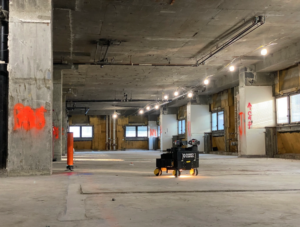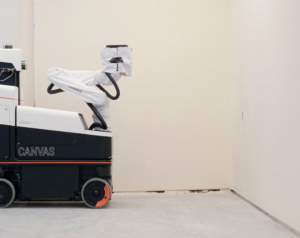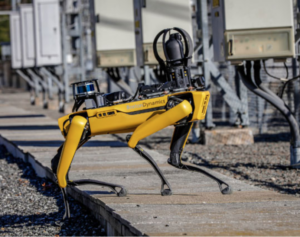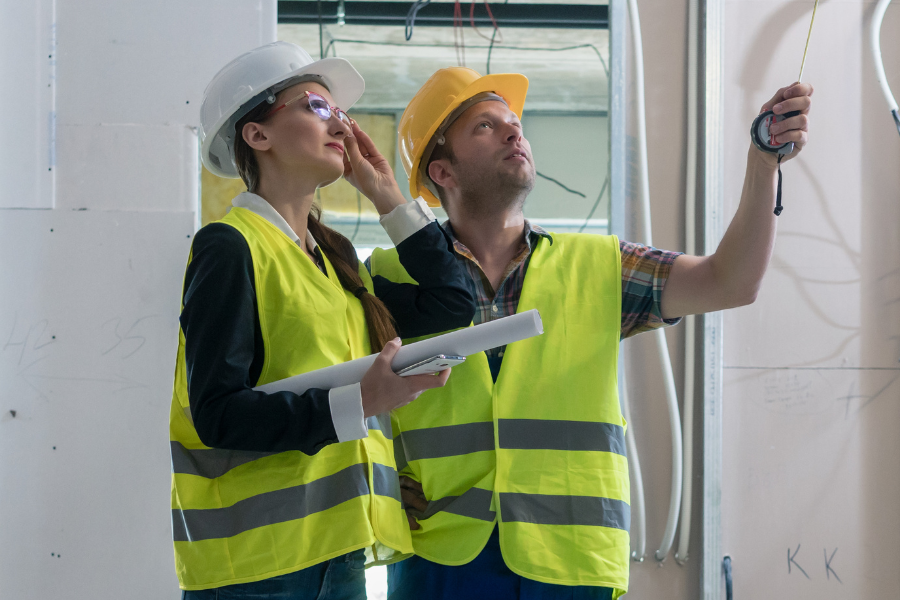Construction is at an exciting point, with the rapid development of technology opening the door for greater efficiencies and better work practices. Robotics, in particular, are changing the landscape; providing opportunities to improve productivity, safety, and quality in interior construction.
It’s interesting to see in many instances, how these robotic solutions support workers in their tasks rather than replacing them.
Here are three cutting-edge robots that we’re pretty excited about:
-
Rugged Robotics Layout Robot – A robot designed to solve practical solutions so workers can build more accurately

The Houston-based startup, Rugged Robotics, developed a robot that prints building layouts on the floor of construction sites, guiding workers on where and where not to build. Known as the “layout Roomba,” the robot is not designed to replace humans, but to increase accuracy in construction projects. Rugged Robotics aims to simplify the deployment of workers and eventually allow unmanned, overnight work.
This robot, which has raised around $12 million in funding to date, has seen increased interest in the wake of the pandemic thanks to the accelerated adoption of automation in construction.
2. Canvas Drywall Robot – Reduces downtime and creates less dust providing a faster and safer work environment

Construction robotics startup Canvas has introduced a drywall finishing robot. This robot automates two of the toughest parts of the drywall finishing process: mudding and sanding, but still uses a human to complete the job. By using the robot, Canvas Certified Finishers can complete a project in less time, while producing predictably high-quality finishes.
The system also captures 99.9% of the dust produced in the sanding phase, improving air quality for workers. Canvas ensures tradespeople can work longer, more productively, and in a safer environment.
Founded in 2017, Canvas robotic engineers have spent three years improving the product before launching publicly. In March this year, Canvas announced a strategic partnership with HILTI and in May announced a strategic partnership with USG. This is definitely one to watch in the near future.
3. Spot Inspection Robot by Boston Dynamics – Traversing dangerous environments

Boston Dynamics’ Spot robot is an industrial inspection robot with exceptional mobility. It is designed to navigate unstructured and dangerous environments where wheeled robots and drones can’t go.
Spot can be programmed to carry out repeatable autonomous missions, gathering consistent data on a predetermined schedule. Web-based control software allows the user to follow-along remotely as Spot goes about its missions, or to teleoperate Spot and review data in real-time.
Spot can also be equipped with sensor payloads for thermal sensing, visual inspection, gauge reading, leak detection, and laser scanning, making it a versatile tool for a range of inspection tasks.
Equipped with autonomous self-charging capabilities, Spot can operate remotely for extended periods and perform lengthy inspection missions.
What do these technological developments mean for interior construction in New Zealand?
Without doubt, the future of interior construction is becoming increasingly automated and the development of robotics is offering new ways to increase efficiency, improve safety, and maintain high-quality standards. While the capital cost of robots can be expensive, the cost savings will make financial sense for organisations who currently do high volumes of work. They also offer a competitive platform for new entrants to construction. It’s an exciting time for the industry, with these robots and others like them, paving the way for innovative practices that could redefine the way we build and maintain our interior spaces.
NAVIGATING EXPECTATIONS: THE REALITY OF BIM FOR INTERIORS
The engineering details for interiors tends to be short, fast and with the potential for many clashes, resulting in a…
NAVIGATING CHANGE AND EMBRACING GROWTH: A CONVERSATION WITH IRINA CHERKASOVA
From the return to the office post-COVID to the impacts of governmental shifts on the industry, Irina provides candid…
HOW STRONG VALUES DRIVE CONFIDENT DECISION MAKING
Essentially, every decision made is crucial to our success, and yet we want our people to make these decisions…


